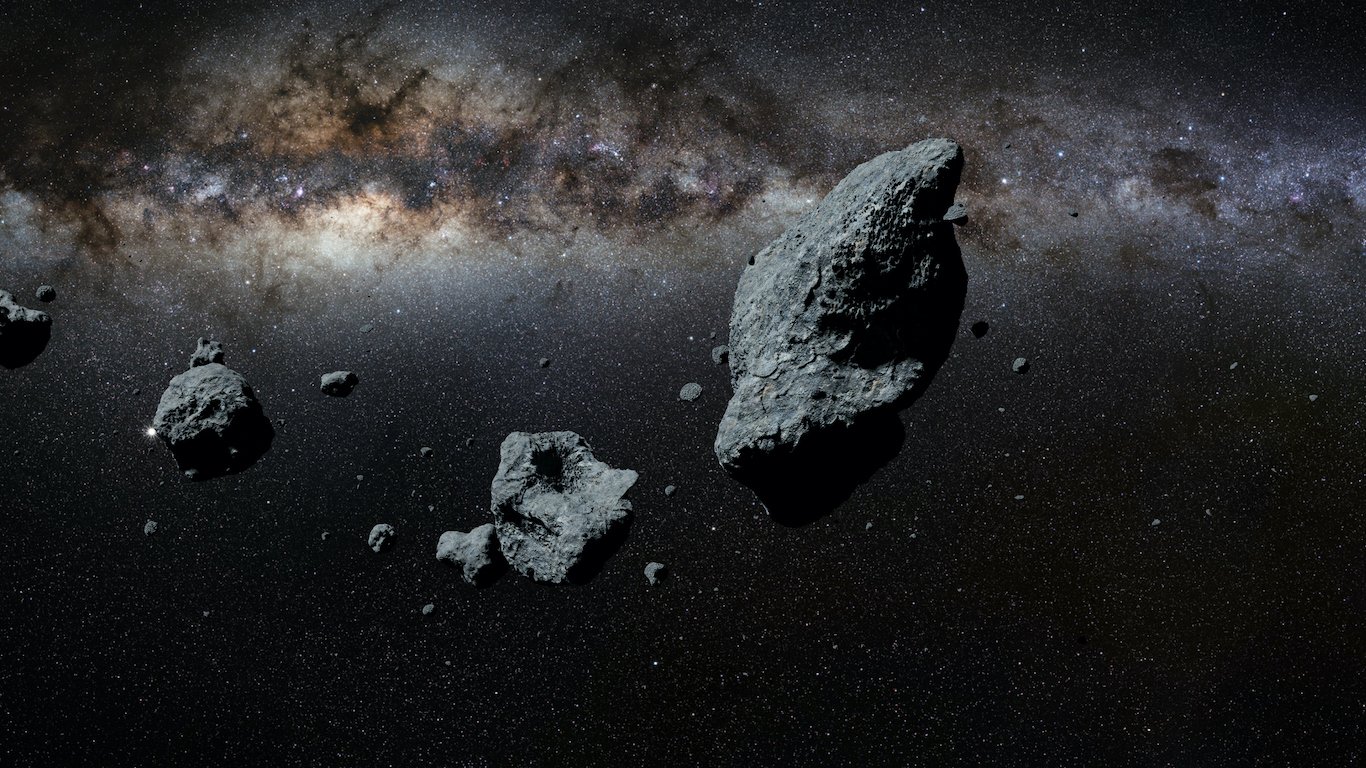

Space is enormous beyond imagination, but just as human-generated trash fouls the seemingly boundless vastness of our oceans, litter from human space exploration is contaminating our tiny corner of the cosmos. While naturally occurring asteroids can threaten our existence, space debris can damage spacecraft and satellites in orbit as well as pose a threat to our well-being on Earth.
Space exploration began when the Soviet Union launched the first satellite, Sputnik 1, in 1957, setting off a furious race to conquer and exploit the void above us. After six decades, it has been estimated that there were well over a million pieces of debris from exploded, crashed, or abandoned objects orbiting Earth, mainly satellites and satellite detritus.
These space-age flotsam travel at extreme speeds in orbit around Earth, threatening damage to exploratory missions and satellites. During the Space Shuttle program, which was suspended in 2011, spacecraft windows had to be replaced on several occasions because of damage they sustained from objects less than 0.04 inches in diameter. Space debris can also collide with other pieces of junk and create more dangerous fragments. The largest pieces of space junk could cause injury and damage on Earth if allowed to fall from orbit in an uncontrolled descent.
More remote, but potentially more devastating, is the threat posed by asteroids and other non-Earth objects (NEOs). Large numbers of these circle the sun, with a relative few coming close to Earth. In its distant past, Earth was twice devastated by huge asteroids with miles-wide dimensions, one 66 million years ago which famously ended the reign of dinosaurs, and one 3.2 billion years ago at the dawn of life on Earth. Fifty thousand years ago, a meteor crashed into our own state of Arizona, leaving a crater nearly a mile wide. In more modern times, much smaller asteroids, measured in feet, have caused injury and damage in Russia (2013) and Siberia (1908).
Scientists have put in place mechanisms and protocols for tracking space hazards, and they continue to improve systems to deflect or destroy objects that threaten orbiting spacecraft or Earth itself, but these systems are imperfect and incapable of eliminating all risks.
24/7 Tempo has researched 25 space objects that have some potential for doing damage to Earth or the use of the space around it.
Click here to see the 25 most dangerous things around the Earth right now

1. SNAP 10-A
> Type of object: Nuclear fission satellite
SNAP 10-A, the first nuclear reactor placed in orbit, was part of a U.S. government project experimenting with power production in space (SNAP standing for System for Nuclear Auxiliary Power). The satellite was launched in 1965 but performed for only 43 days because of an electric system failure. The satellite is still in orbit where it is predicted to remain for 3,000 years, vulnerable to collision and release of nuclear radiation.
[in-text-ad]
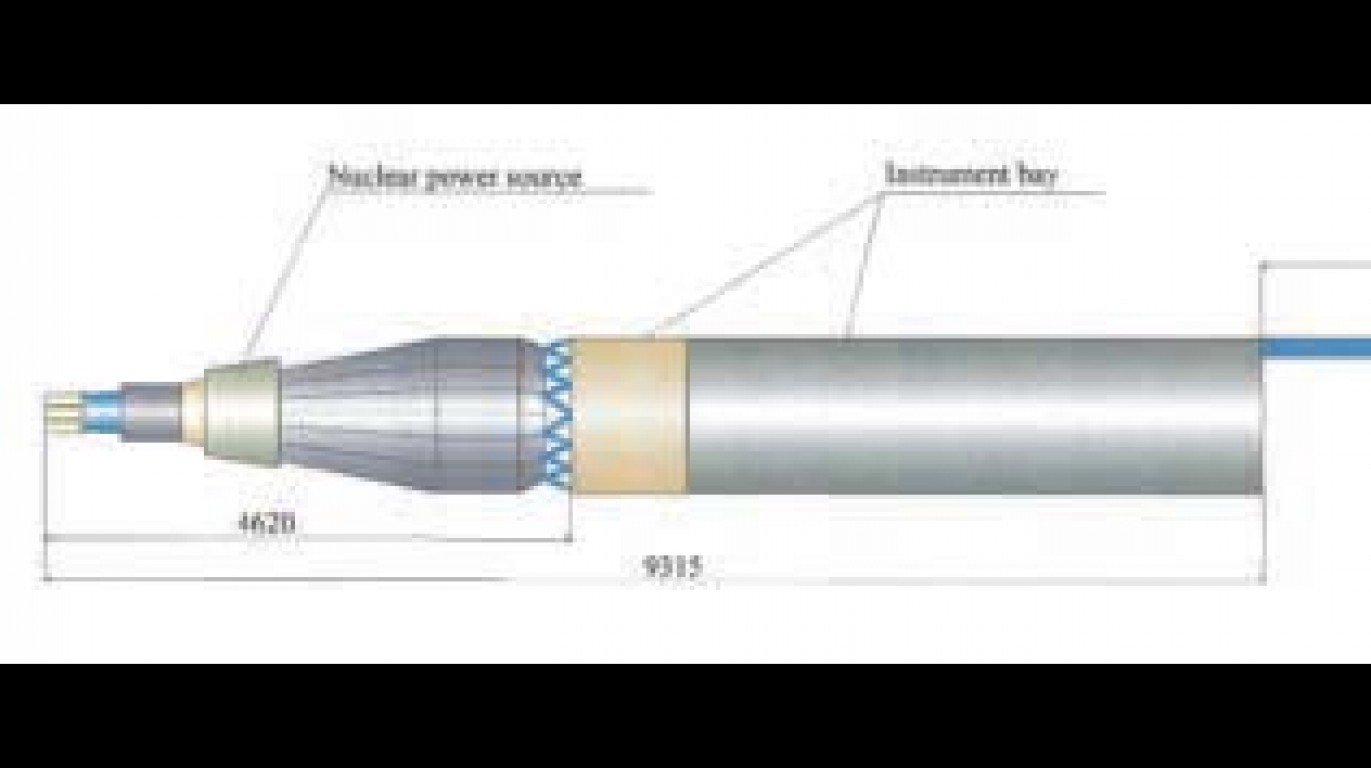
2. Kosmos 1818
> Type of object: Nuclear spy satellite
By the time the Soviet Union launched Kosmos 1818 in 1987, an earlier nuclear satellite had fallen out of orbit, leaving a trail of radioactive debris over northern Canada. The Soviets launched Kosmos 1818 into a higher orbit to avoid another debacle, but in 2008, the satellite began fragmenting and leaking what is thought to be coolant after a collision or other system failure. According to Russian sources, the satellite is expected to burn up in Earth’s atmosphere when it leaves orbit in 2045.

3. Kosmos 1867
> Type of object: Nuclear spy satellite
Kosmos 1867 was launched at the same time as its sister satellite, Kosmos 1818, with an updated power supply system and, for safety reasons, into an orbit farther from the Earth than most satellites. Its useful life ended over 30 years ago, so it remains in orbit as nuclear space junk.
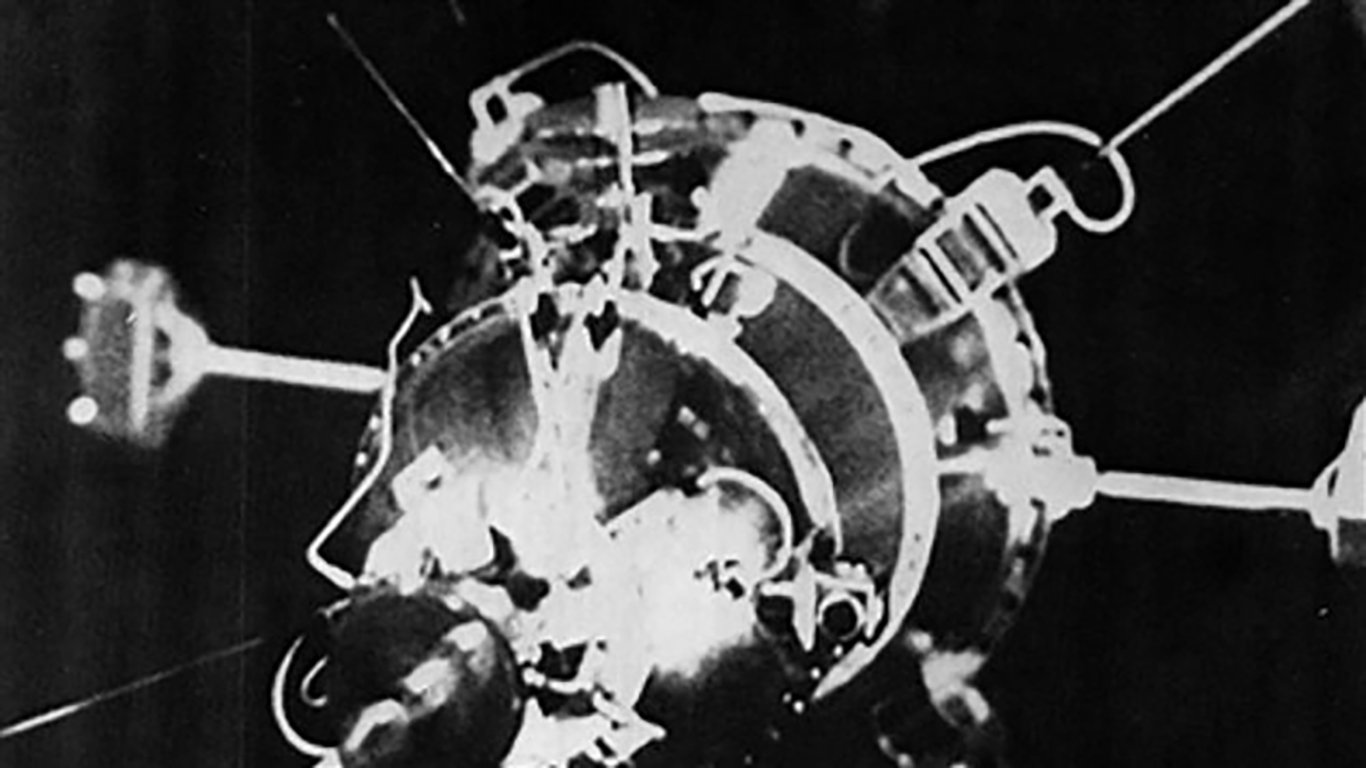
4. Kosmos 1900
> Type of object: Nuclear spy satellite
Launched in 1987, Kosmos 1900 was one of dozens of soviet nuclear spy satellites placed in orbit. It began an uncontrolled descent in April of the next year. Weeks of tense uncertainty followed as the satellite kept descending to unstable orbits and continued to fall. The soviets issued alternate reports, declaring both full orbital correction and complete thermal destruction in the atmosphere. Finally, in October, a safety mechanism kicked in and lifted the satellite and its nuclear reactor back into a high orbit, where it remains today. A radioactive cloud is now orbiting in space after the reactor on Kosmos 1900 collided with something causing it to leak its coolant.
[in-text-ad-2]

5. Iridium 33 and Kosmos 2251 debris
> Type of object: Communication satellites
In 2009, a communications satellite known as Iridium 33 collided with the 16-year-old Soviet era satellite Kosmos 2251 over Siberia, creating over 2,500 pieces of debris, up to a third of which fell into the atmosphere, with the remaining fragments still circling the Earth. The collision was one of two of the worst satellite breakups in history. In 2007, a Chinese satellite had been purposely destroyed in a test of an anti-satellite missile system, creating over 100,000 pieces of debris. Scientists estimate that the litter created by these two events account for about a third of all orbiting space junk.
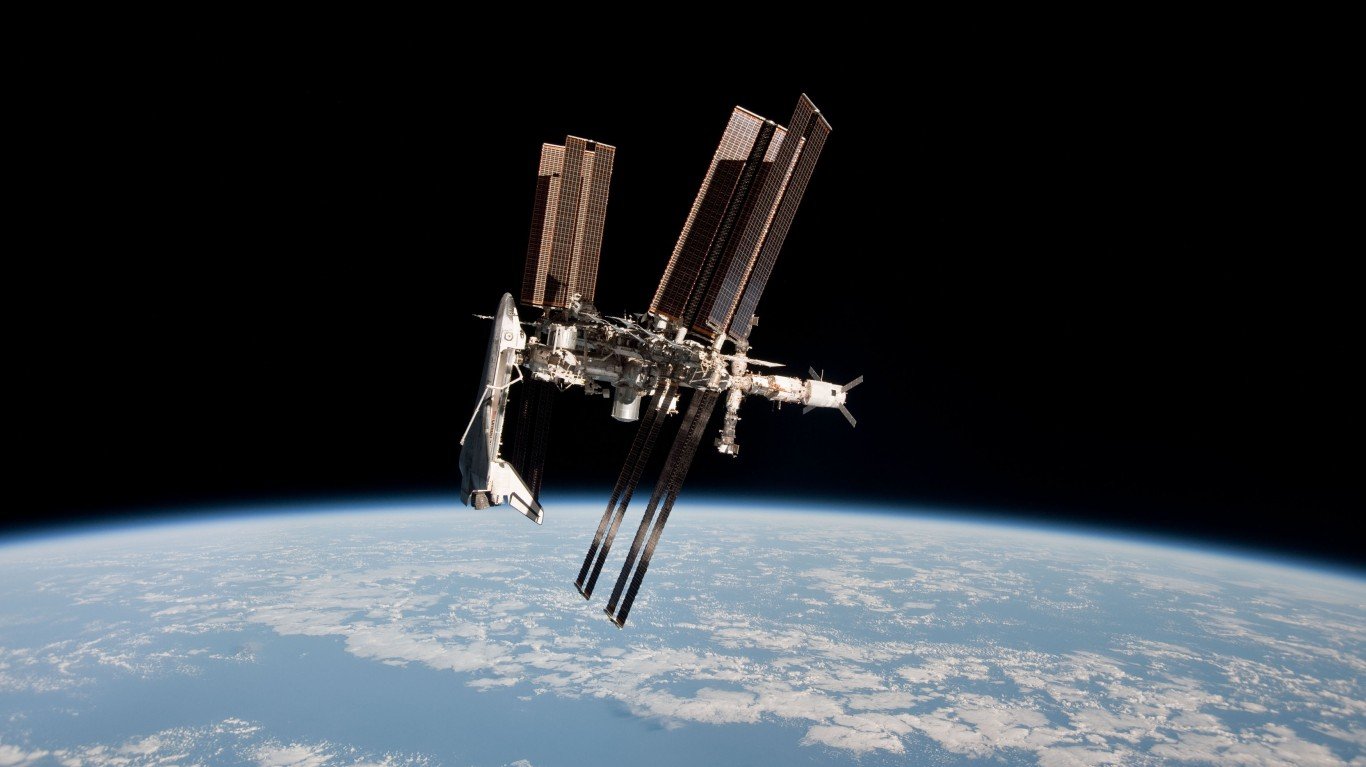
6. International Space Station
> Type of object: Space station
Constructed between 1998 and 2011 with the cooperation of 15 countries, the 420-ton International Space State (ISS) is the largest human-made object in orbit, big enough to be seen from Earth without a telescope. Built and maintained mainly by the United States, the ISS has hosted various missions and experiments conducted by astronauts from around the world, and it is expected to do so into the next decade. After that, its fate is uncertain.
The U.S. could spend hundreds of millions of dollars to either boost the space station into a much higher orbit or to deploy rocket thrusters to control its descent into the atmosphere, in the manner that the Russian space station MIR was destroyed in 2001. A less likely possibility is that a budget-conscious NASA would simply stop employing the boosters used to keep the ISS in orbit. In this case, the ISS would fall into the atmosphere in an uncontrolled descent, like Skylab in 1974, posing a risk of injury and destruction on Earth.
[in-text-ad]
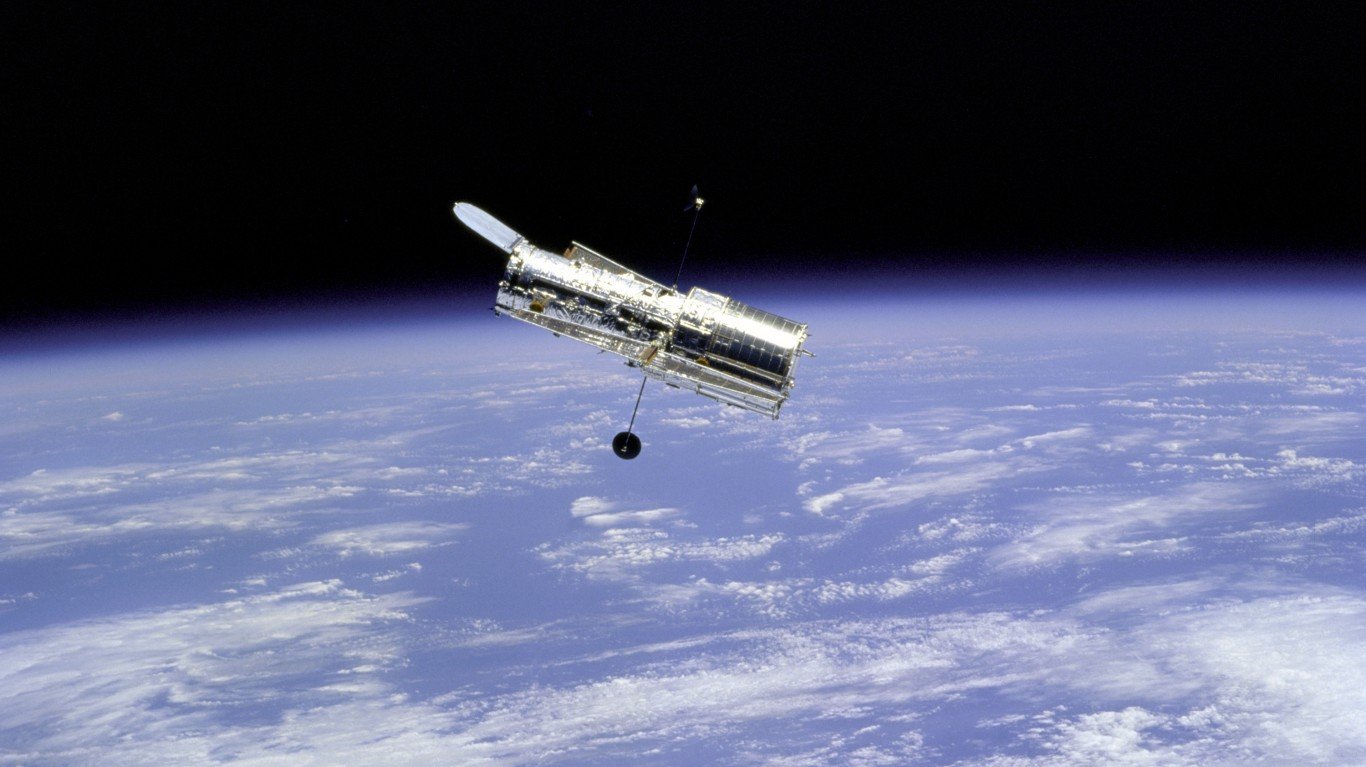
7. Hubble Space Telescope
> Type of object: Space telescope
In 1990, NASA, in cooperation with the European Space Agency (ESA), placed the first space observatory into orbit, beyond the haze of Earth’s atmosphere. In the years since, and with the help of five service missions, the Hubble telescope has produced over 1.3 million images of the solar system and the stars and galaxies beyond.
However, the 27,000 pound solar-powered observatory is nearing the end of its useful life, meaning that NASA will have to either engineer a controlled return to Earth, boost the craft into higher orbit, or design a new mission that would increase Hubble’s longevity. Until a plan is put in place — and succeeds — Hubble’s orbit will continue to decay due to Earth’s drag, potentially resulting in disastrous uncontrolled reentry some time between 2028 and the mid-2030s.
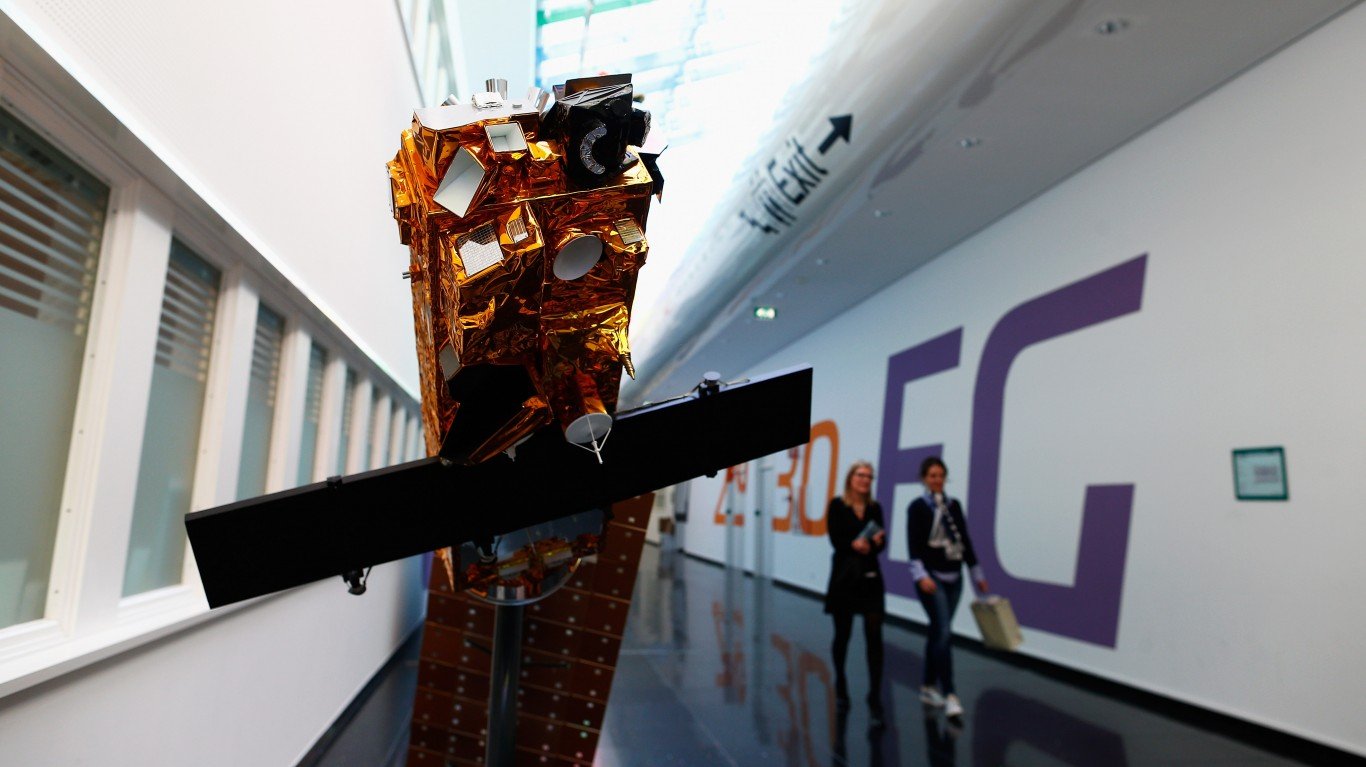
8. Envisat
> Type of object: Earth-observing satellite
For a decade — twice the length of its projected usefulness — the satellite launched by the ESA monitored the environmental health of the Earth, from natural disasters to the threats caused by humans to our planet, such as pollution, and the effects of climate change. Known as Envisat, the satellite sent back huge caches of information that has formed the basis for thousands of scientific papers and a better understanding of the ominous changes to our environment, particularly the loss of arctic ice.
Without warning, Envisat stopped communicating in April of 2012, and its status and location are now unknown. Given its size, 85 by 32 feet, and weight, about 18,000 pounds, its uncontrolled descent to Earth, predicted to take place over 150 years, poses a risk of injury and damage. In the meantime, scientists believe there is a 15% to 30% chance the satellite will collide with other space junk, creating a major fragmentation event.
9. 109P/Swift-Tuttle
> Type of object: Comet
The Swift-Tuttle comet, discovered in 1862, orbits the sun every 133 years, leaving a trail of dust in its wake. Earth’s annual passage through the comet’s trail produces the famous Perseids meteor shower every August. Since its discovery, some astronomers have predicted the comet’s collision with Earth, a particularly startling prediction given the comet’s immense size, about 16 miles across. The comet does come relatively close to Earth — in its pass in 3044 it would come as close as a million miles to the Earth, only twice the distance from Earth to the moon. Still, more accurate calculations provided assurance that Swift-Tuttle poses no real threat to Earth.
[in-text-ad-2]
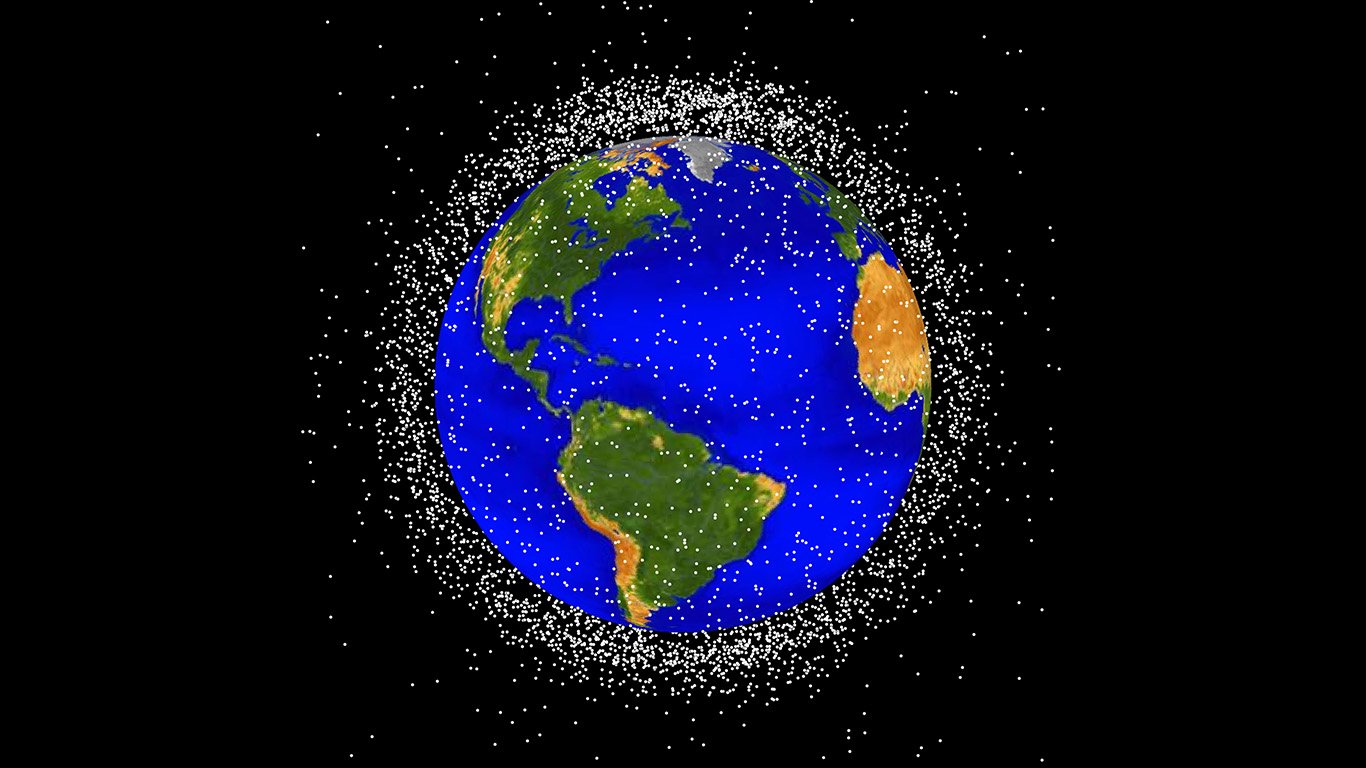
10. 14,000 pieces of space debris
> Type of object: Space debris
There are perhaps millions of pieces of debris from objects humans launched into space. The debris pieces, known as space junk, are orbiting the Earth. Over 14,000 of these pieces measuring 4 inches and larger are being tracked by the U.S. Space Surveillance Network. Astronauts can employ debris avoidance mechanisms when tracked objects threaten a space mission, but even the smallest fragments, measuring a fraction of an inch, can damage spacecraft because of the high speeds in which they travel. The risk of a disastrous collision between space debris and the International Space Station was determined to be 1 in 300, and with the Hubble Telescope, 1 in 184.
Scientists have raised the possibility of a single collision between a satellite and space junk setting off a chain of collisions and creating clouds of debris so dense as to make Earth’s orbits unusable.
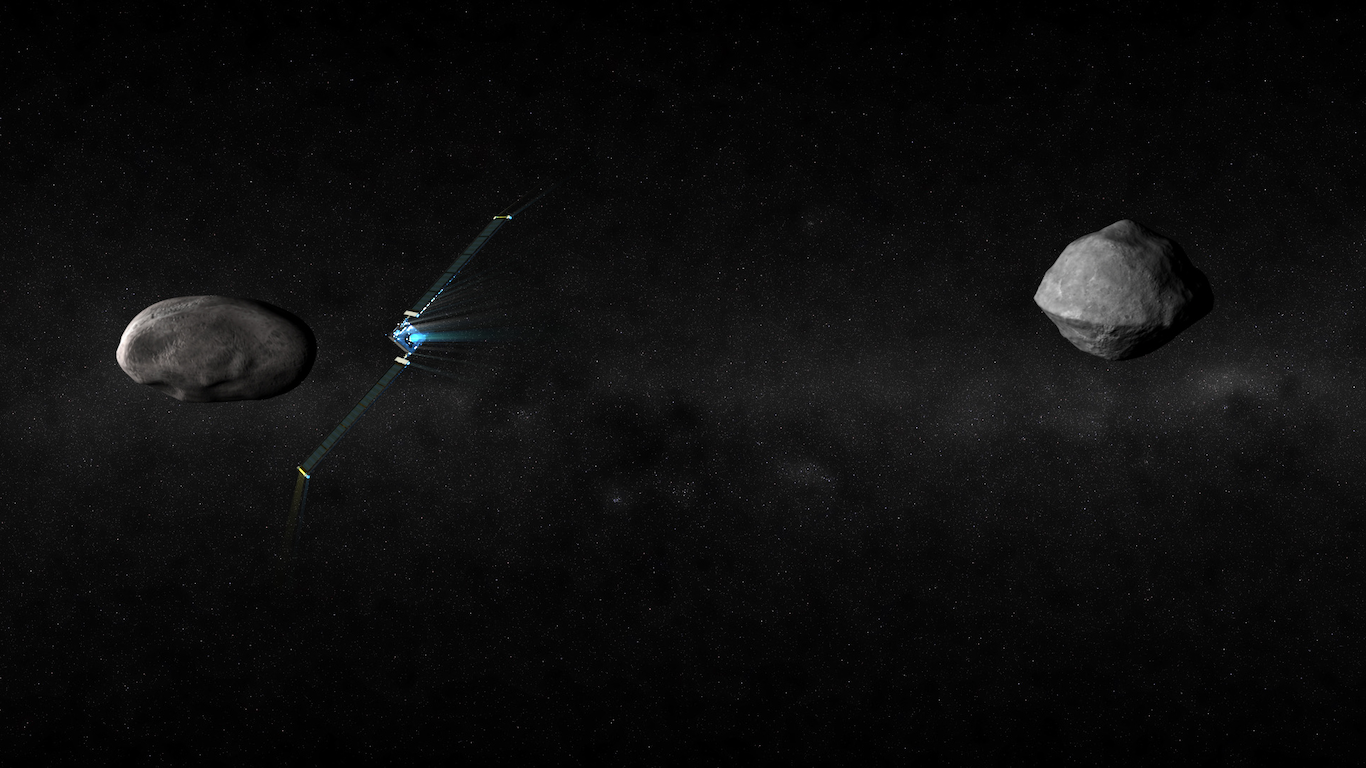
11. Didymos A
> Type of object: Asteroid
Scientists have classified a number of near-Earth objects as potentially hazardous asteroids, or PHAs, because of their size and orbits that periodically bring them close — in space terms — to Earth. Didymos, which is about half a mile in size, is a PHA that travels around the sun every two years, often coming close to Earth. In 2003, it came within 4.45 million miles of Earth. In 2123, it will come within 3.33 millions miles, and in 2144, within 2.91 million miles.
[in-text-ad]
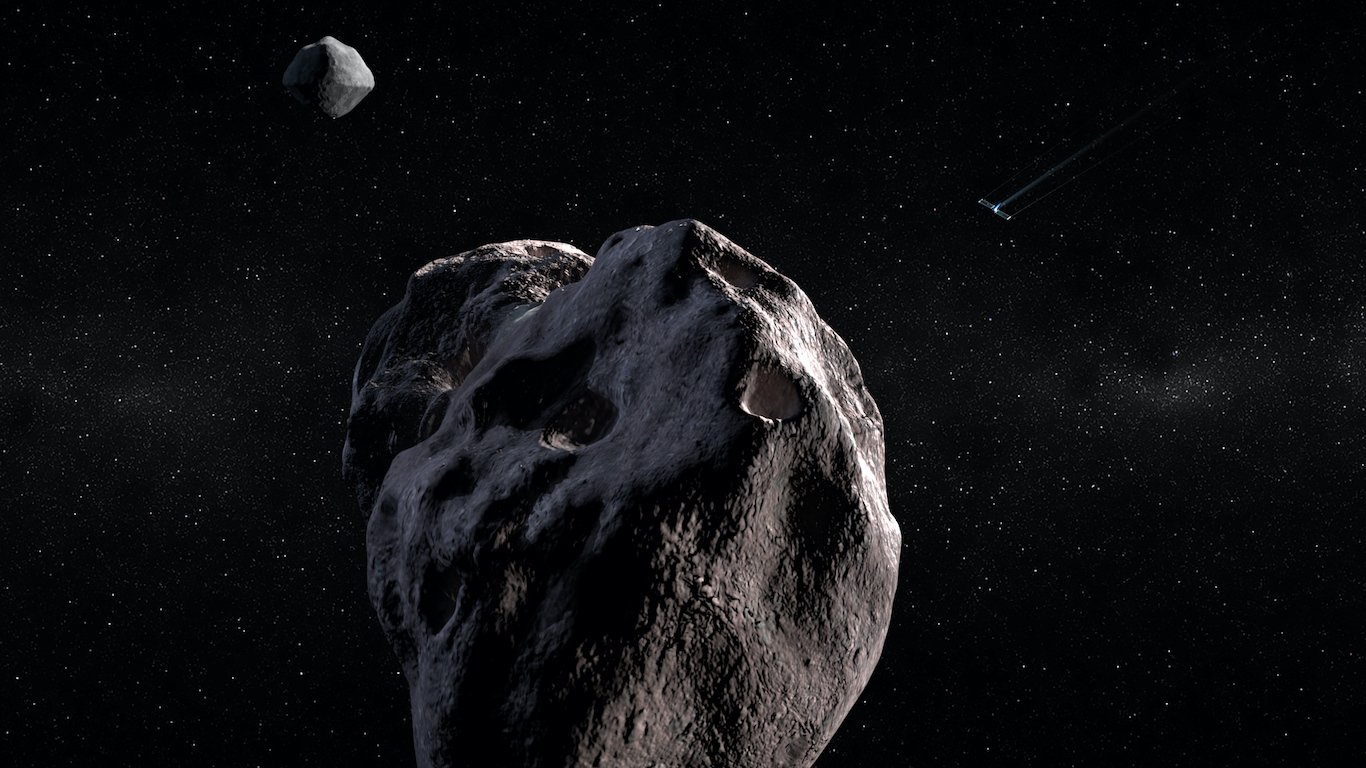
12. Didymos B
> Type of object: Asteroid
Didymos B is the relatively tiny (about 558 feet across) moon of Didymos A, which is about 2,560 feet across. NASA, working with the ESA, will use Didymos to begin testing a system designed to deflect near-Earth objects from a collision course with Earth. The double asteroid redirection test, or DART, will target Didymos in a launch scheduled for next year, with impact the following year. If the test is successful, it will very slightly alter the orbit of Didymos B around Didymos A.
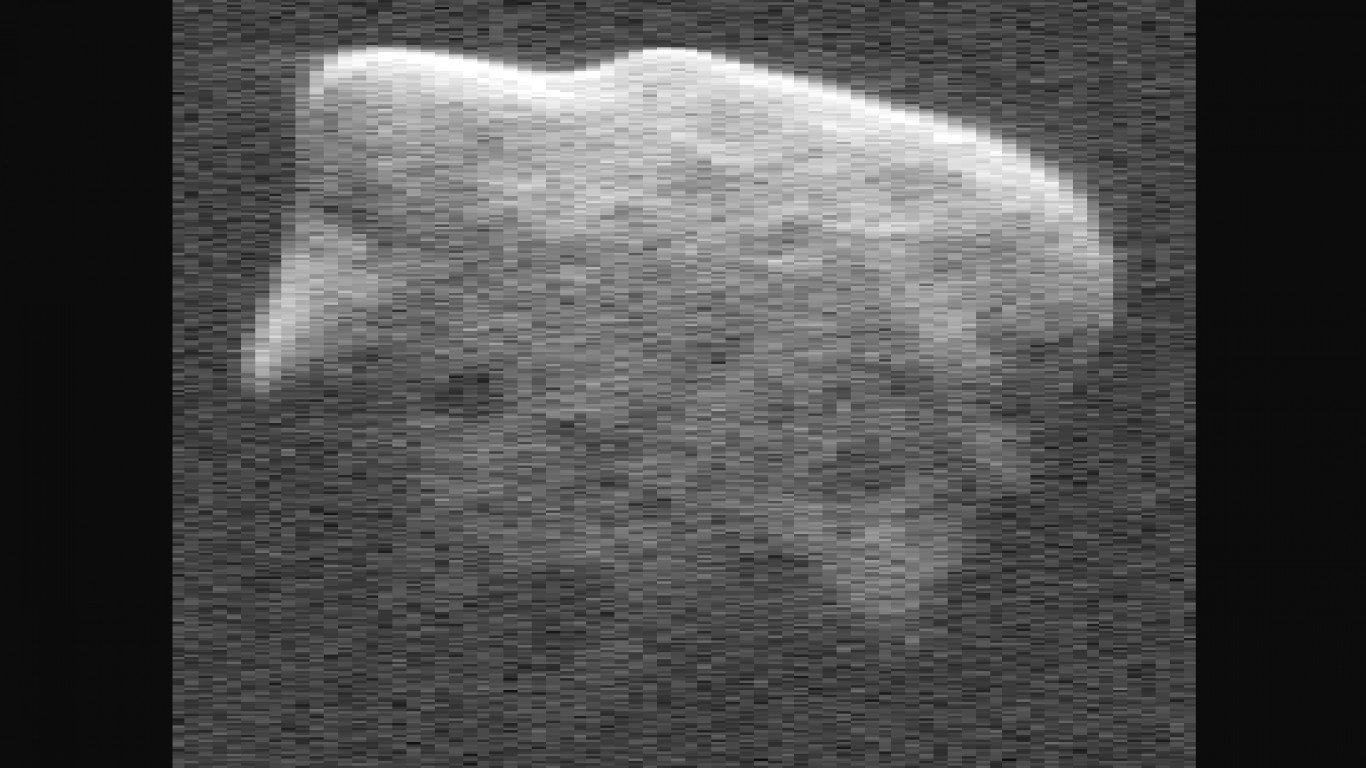
13. (53319) 1999 JM8
> Type of object: Asteroid
At 4 miles in diameter, JM8 is the largest of all PHAs. Though it has come as close as a few million miles from Earth in the last century, when it next approaches Earth in 2075 it will be at a distance of 23.8 million miles. In 2137, it will close in again at 7.1 million miles. For comparison, Venus is just 25 million miles away.
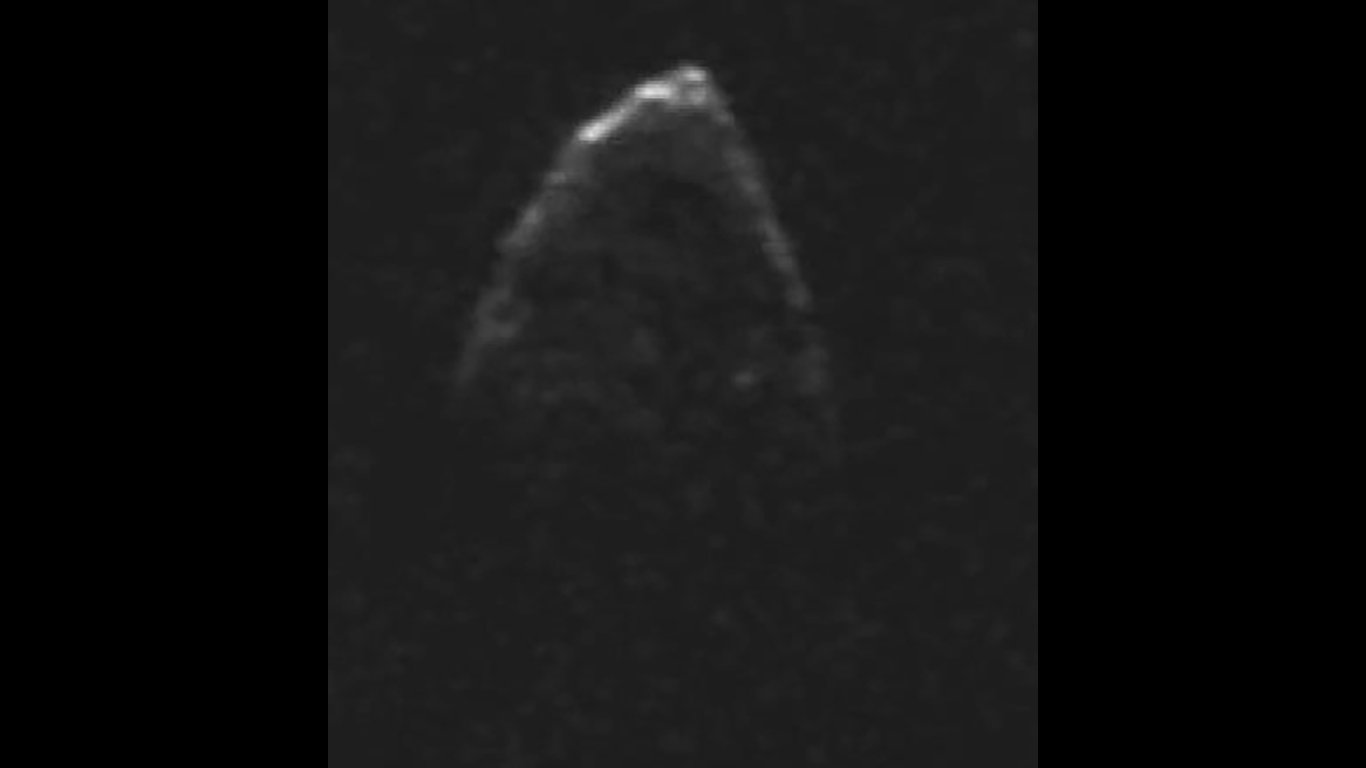
14. 29075 (1950 DA)
> Type of object: Asteroid
As part of its Sentry monitoring system, NASA lists asteroids that pose some risk, however small, of hitting the Earth in the next 100 years. Asteroids are listed in order of their rating on the Palermo Technical Impact Hazard Scale, which measures both the probability of an asteroid’s collision with Earth and the amount of energy that would be released on impact.
For the last several years, the PHA known as 1950 DA has been given the highest Palermo rating because of its large size, about two-thirds of a mile in diameter, and the devastating impact it would have on the biosphere and climate were it to strike Earth. Still, the chance of such an encounter on the next closet visit in 2880 is 1 in 8,300.
[in-text-ad-2]
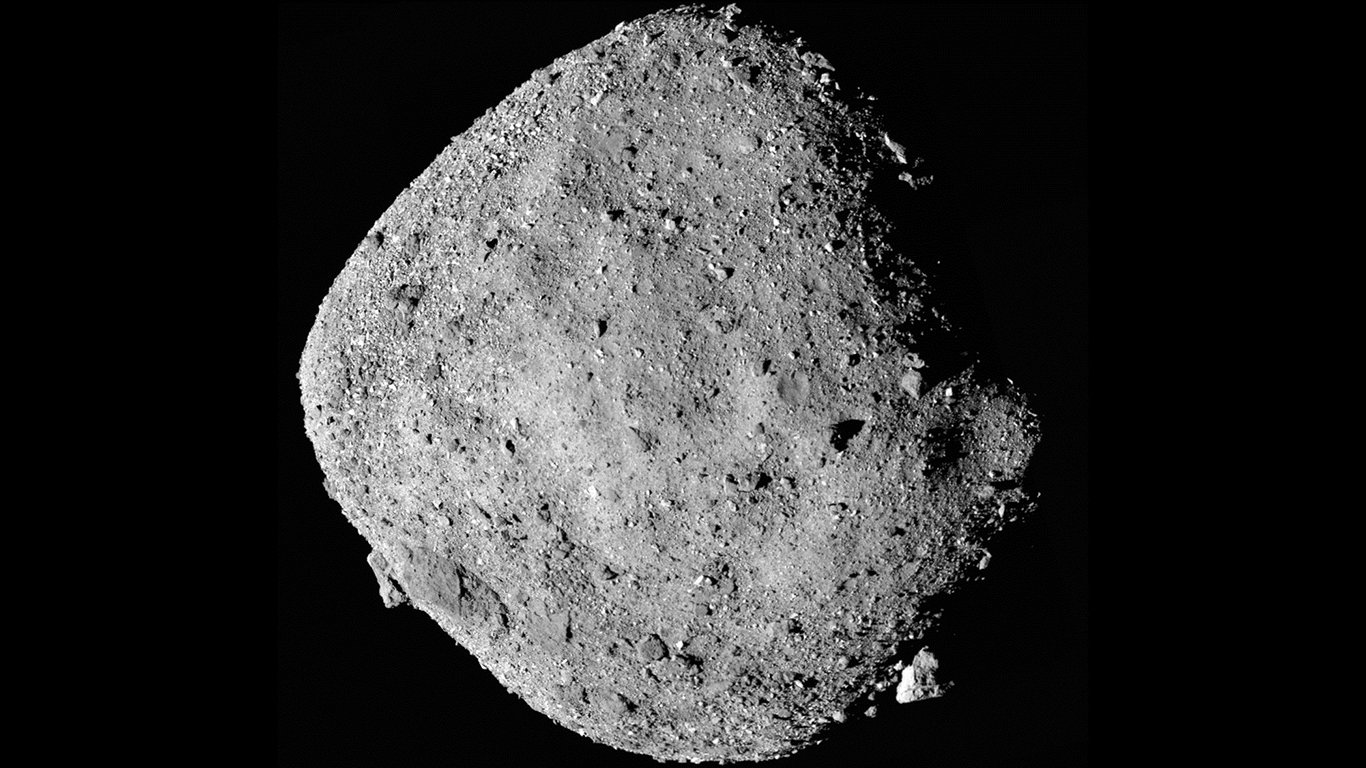
15. 101955 Bennu (1999 RQ36)
> Type of object: Carbonaceous asteroid
The asteroid known as Bennu is second only to 29075 (1950 DA) on the Palermo Scale. About one-third of a mile in diameter, it has been described by a NASA scientist as a pile of rubble because of its low density. Its chance of colliding with Earth in its next near visit is 1 in 2,700.
16. 99942 Apophis (2004 MN4)
> Type of object: Asteroid
Apophis, which has a diameter of about a fifth of a mile, rounds out the top three on the Palermo Scale. Soon after it was discovered in 2004, a group of astronomers gave the asteroid a 1 in 60 chance of striking Earth in May 2029 — on Friday the 13th. Subsequent data and analysis eliminated that possibility. Still, on May 13, 2029 — which will be Friday the 13th — people will be able to see the movement of a very bright asteroid, visible with the naked eye even in daylight, as Apophis passes at a distance of only 18,600 miles from Earth. This is so close that if the asteroid passes through at a slightly different angle than predicted, there will be a small possibility of a collision in 2036 or 2069.
[in-text-ad]
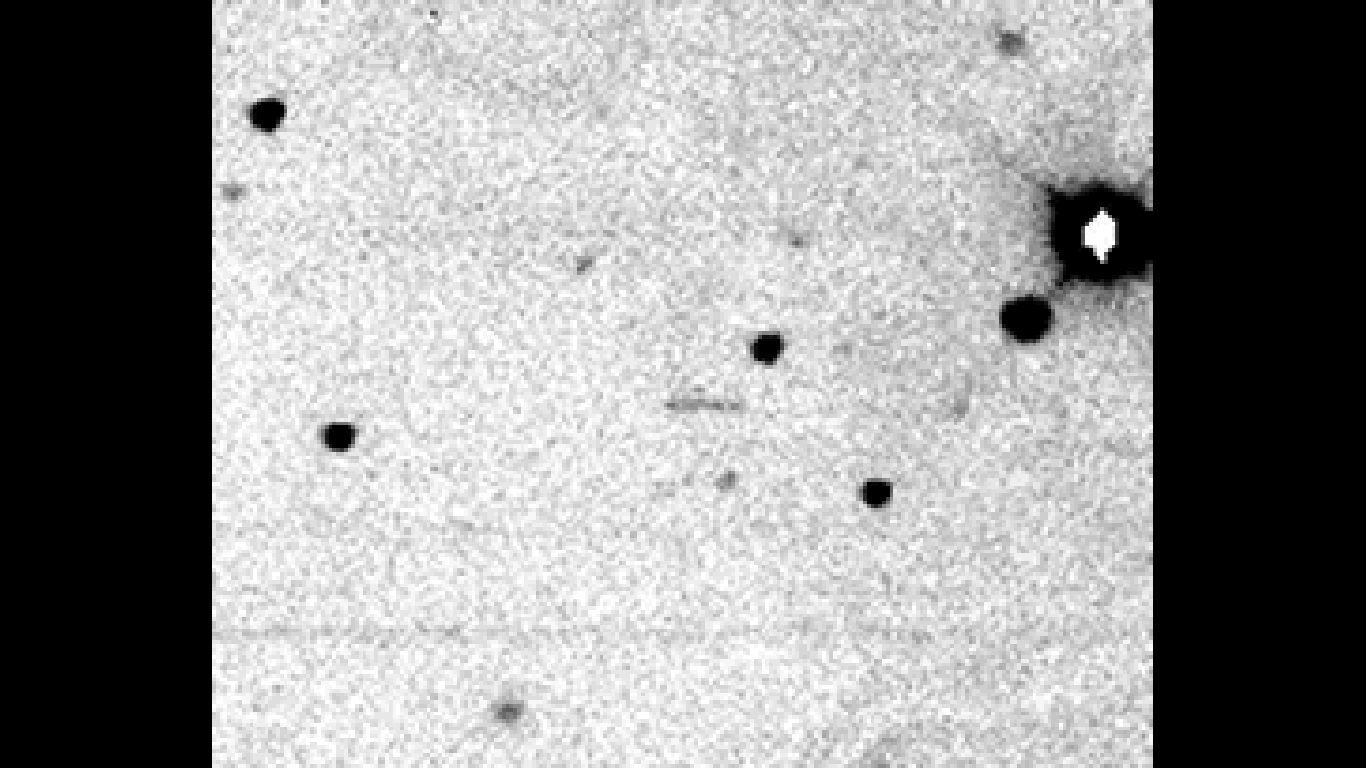
17. 2000 SG344
> Type of object: Asteroid
In the four years following its discovery in 2000, SG344 was viewed as the greatest near-Earth object threat to our Earth, despite its small size of about 125 feet in diameter. Based on further study it is now considered the fourth greatest threat, with about a 1 in 417 chance of a collision with Earth between 2069 and 2113. It would leave a crater 100 feet wide.
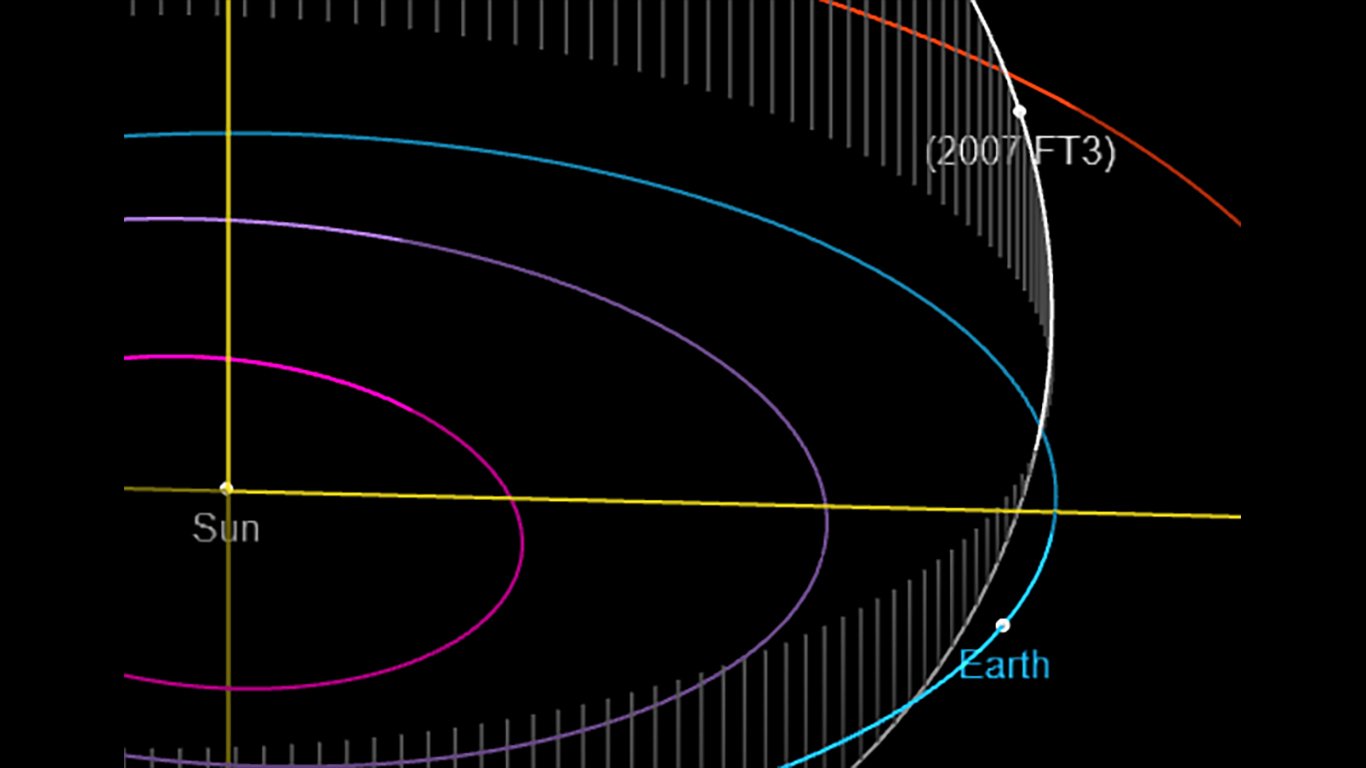
18. 2007 FT3
> Type of object: Lost asteroid
First discovered in 2007, the asteroid FT3 was observable for barely more than a day. Based on its fairly large size, about 1,115 feet in diameter, and the lack of data on its behavior, it has been a source of unsupportable disaster predictions. Scientists have given the asteroid a high risk rating because so little is known about it, but it is believed to have passed the Earth at a distance of 86 million miles in its latest orbit.
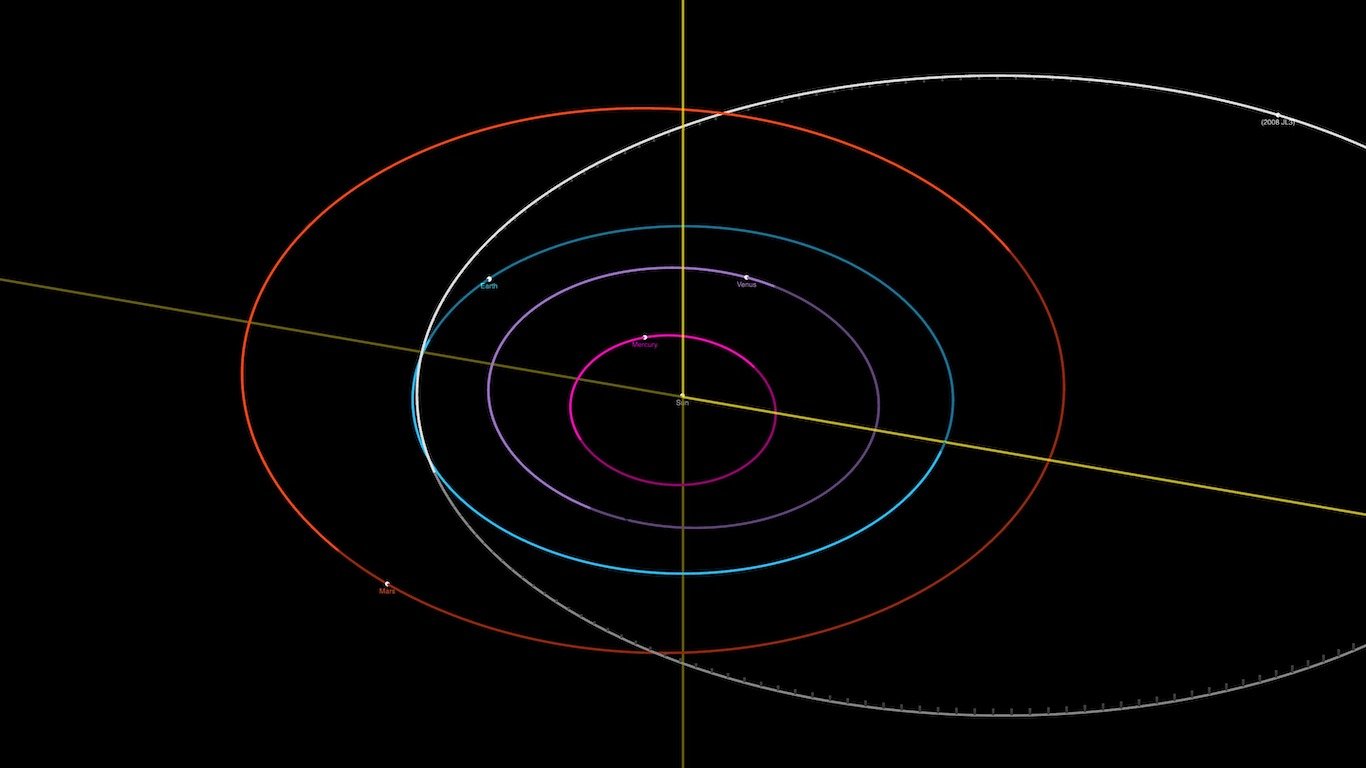
19. 2008 JL3
> Type of object: Asteroid
Though there is a slight possibility of JL3 striking Earth in 2027, 2063, 2071, 2075, or 2090, placing it relatively high on the risk charts, it does not threaten serious damage because of its small size, which is about 95 feet.
[in-text-ad-2]
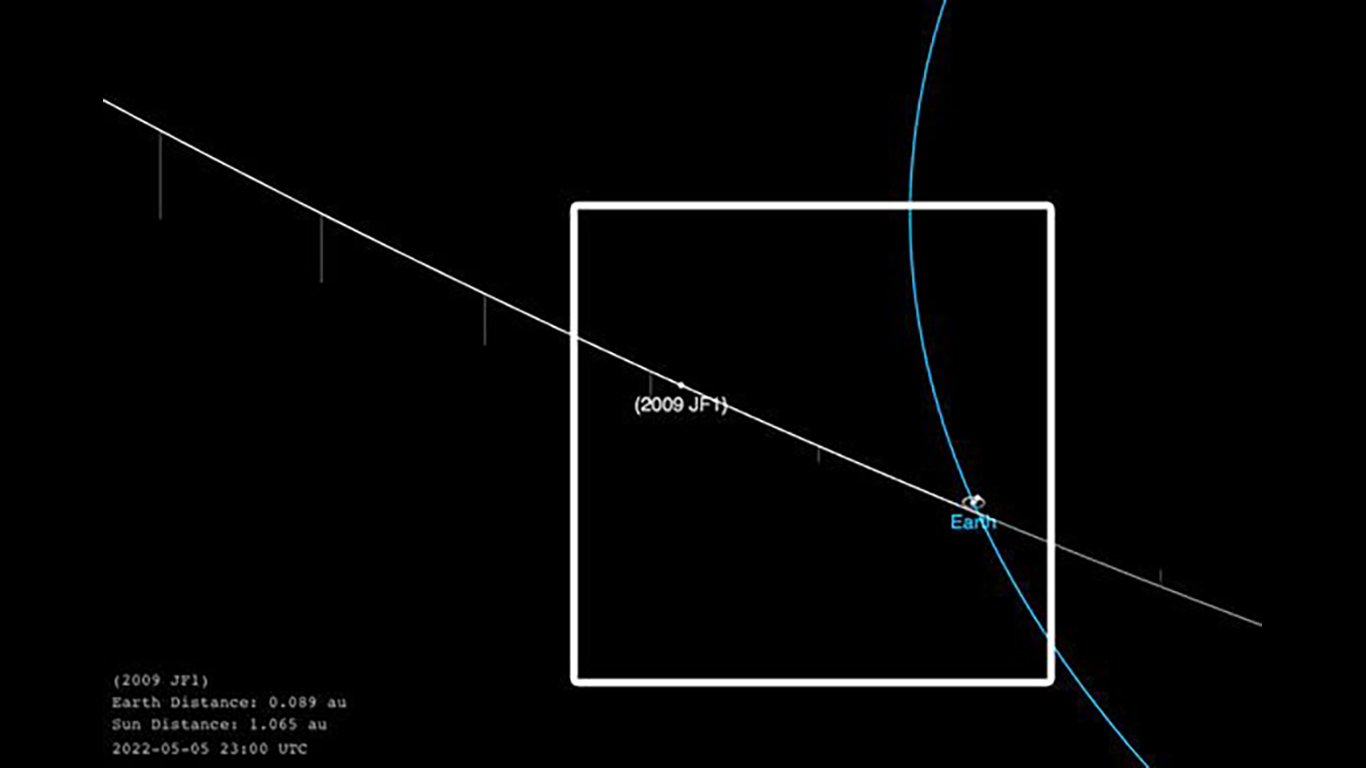
20. 2009 JF1
> Type of object: Asteroid
JF1, a threat to Earth on NASA’s Sentry list, is expected to come close in May of 2022. However, the risk of a collision is low, with a chance of the asteroid of about 43 feet in size hitting Earth about 1 in 3,800, according to NASA.
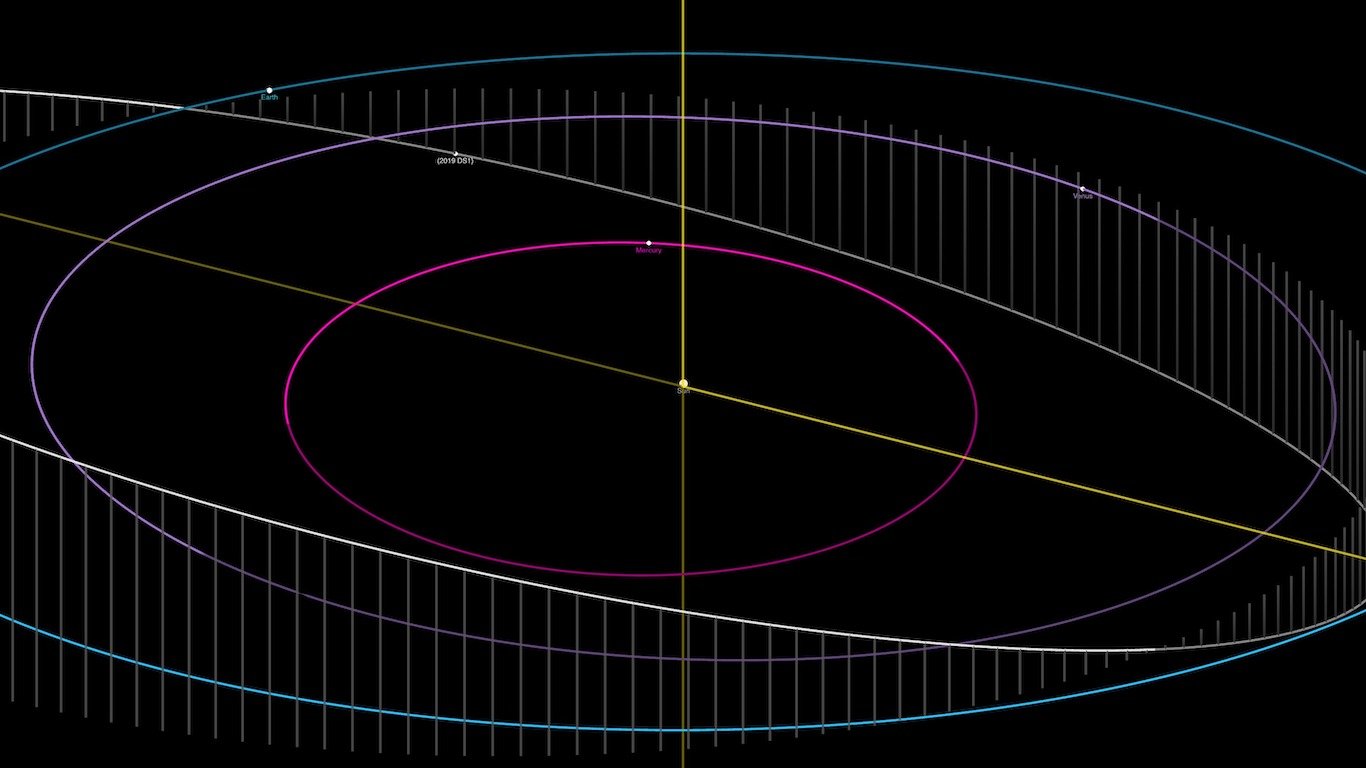
21. 2019 DS1
> Type of object: Asteroid
The next Sentry-listed risk from a near-Earth object is the recently-discovered asteroid DS1, which poses a 1 in 800 risk of hitting Earth in 2082. Even if such a collision occurred, because of its small size — just 82 feet — the asteroid would likely be destroyed upon entering Earth’s atmosphere.
[in-text-ad]
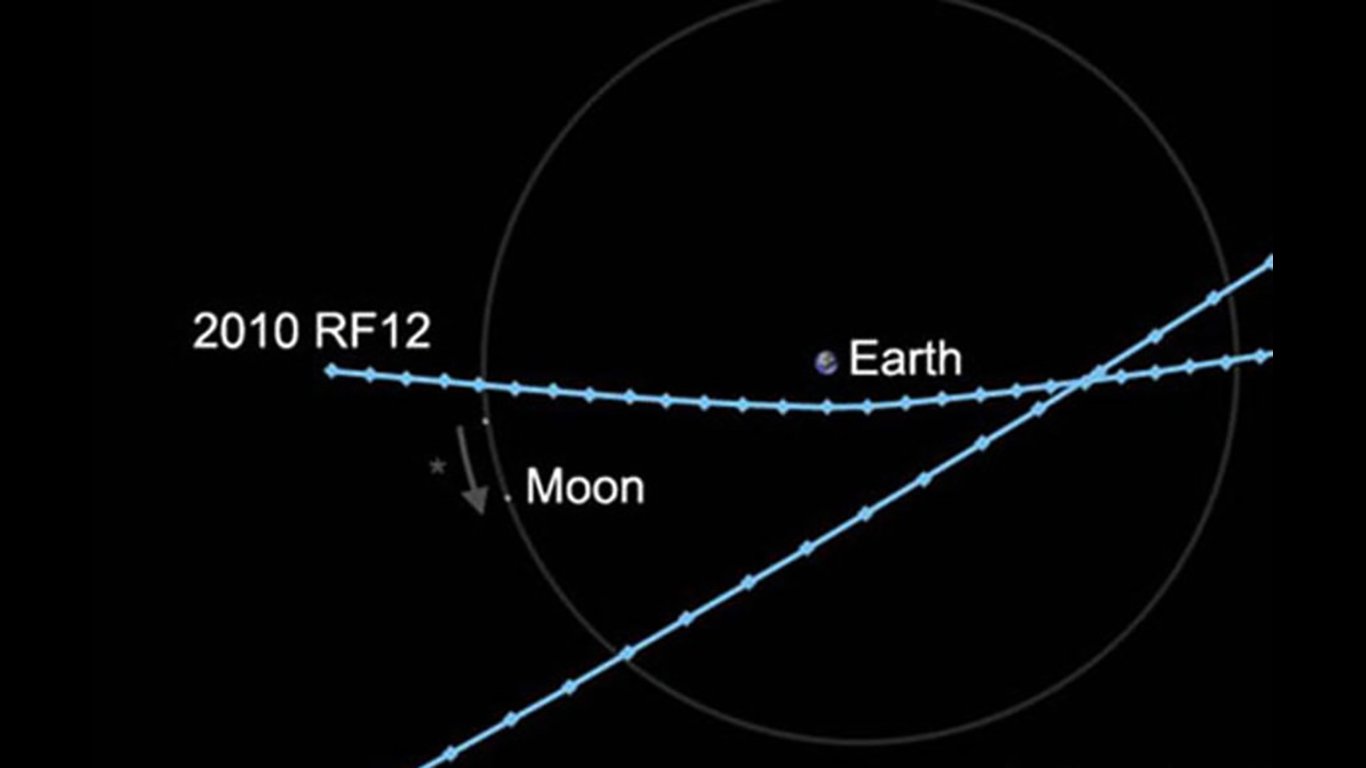
22. 2010 RF12
> Type of object: Asteroid
RF 12 is a very small asteroid — with a diameter of only 23 feet — that came within 49,000 miles of Antarctica in 2010, the year it was discovered. It is expected to come close to Earth many times in the future, with a 5% chance of a collision in September of 2095.

23. Other Asteroids on the Sentry Risk Table
> Type of object: Asteroids
Of the nearly 22,000 near-Earth objects, less than a thousand are listed as a risk by NASA’s Sentry monitoring program, and of these, 43 are considered potentially hazardous objects. However, the list is constantly changing as new observations are made. It is very possible that currently lower-rated asteroids will surpass the risk level of the top 10 listed above.

24. Undiscovered Asteroids
> Type of object: Asteroids
In the summer of 2019, scientists were stunned when a previously unknown asteroid came uncomfortably close to Earth. Dubbed 2019 OK, the asteroid, which may measure up to 427 feet in diameter, passed within 45,000 miles of our planet, less than a fifth of the distance to the moon. The explanation for the surprise is that asteroids are hard to spot. While scientists believe that 90% of the largest asteroids, over 1 kilometer in size (about 0.62 miles), are being monitored, only 1% of all asteroids over 20 meters in size (about 65.5 feet) are accounted for.
[in-text-ad-2]
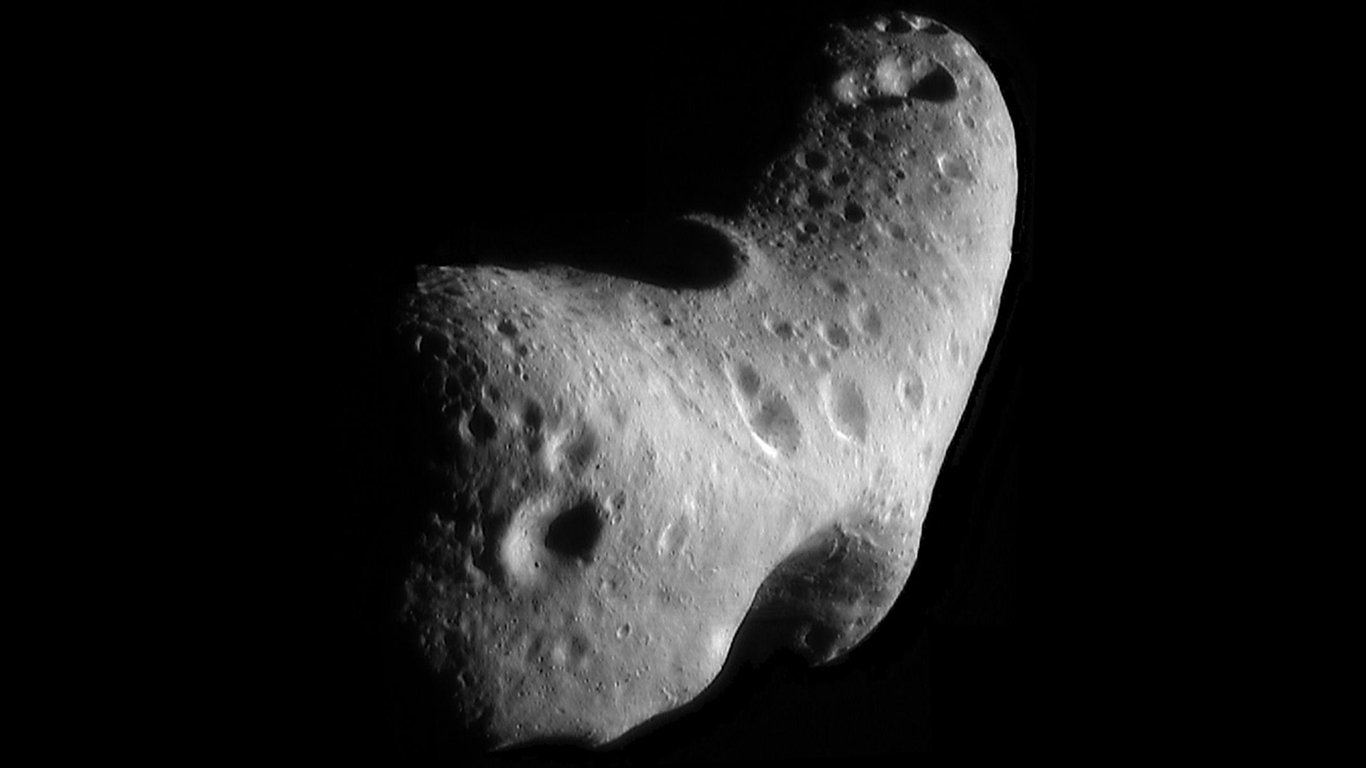
25. Eros 433
> Type of object: Asteroid in Mars’ orbit
Eros is an enormous asteroid — about 14 miles in diameter — that intersects Mars’s orbit as the planet circles the sun, occasionally coming close to Earth’s orbit. Because its trajectory is unstable and easily disrupted, scientists see some chance that the asteroid could eventually cross to our orbit and, potentially, strike Earth. It would be a devastating blow. While scientists see a significant chance of this happening in the next 1.14 million years, there is practically no chance of it happening in the next 100,000 years.
Take This Retirement Quiz To Get Matched With An Advisor Now (Sponsored)
Are you ready for retirement? Planning for retirement can be overwhelming, that’s why it could be a good idea to speak to a fiduciary financial advisor about your goals today.
Start by taking this retirement quiz right here from SmartAsset that will match you with up to 3 financial advisors that serve your area and beyond in 5 minutes. Smart Asset is now matching over 50,000 people a month.
Click here now to get started.
Thank you for reading! Have some feedback for us?
Contact the 24/7 Wall St. editorial team.
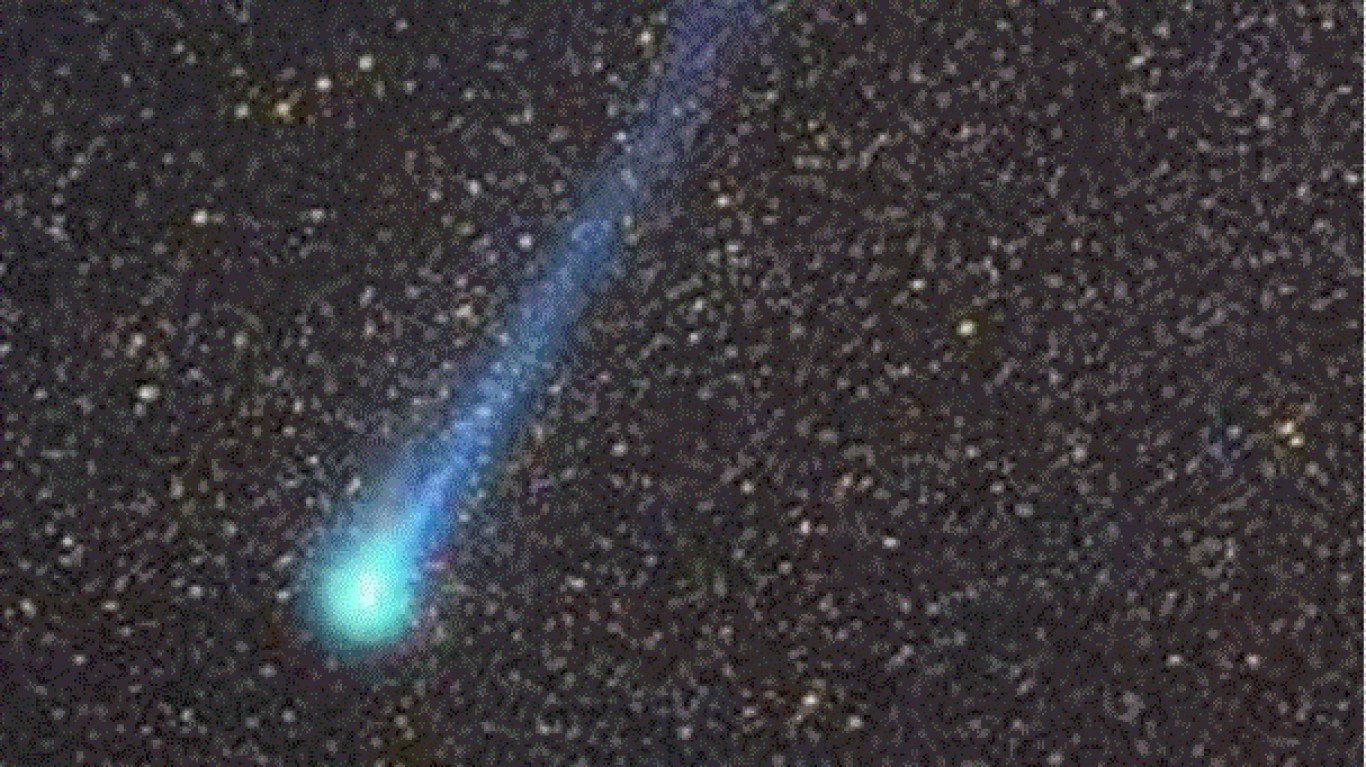
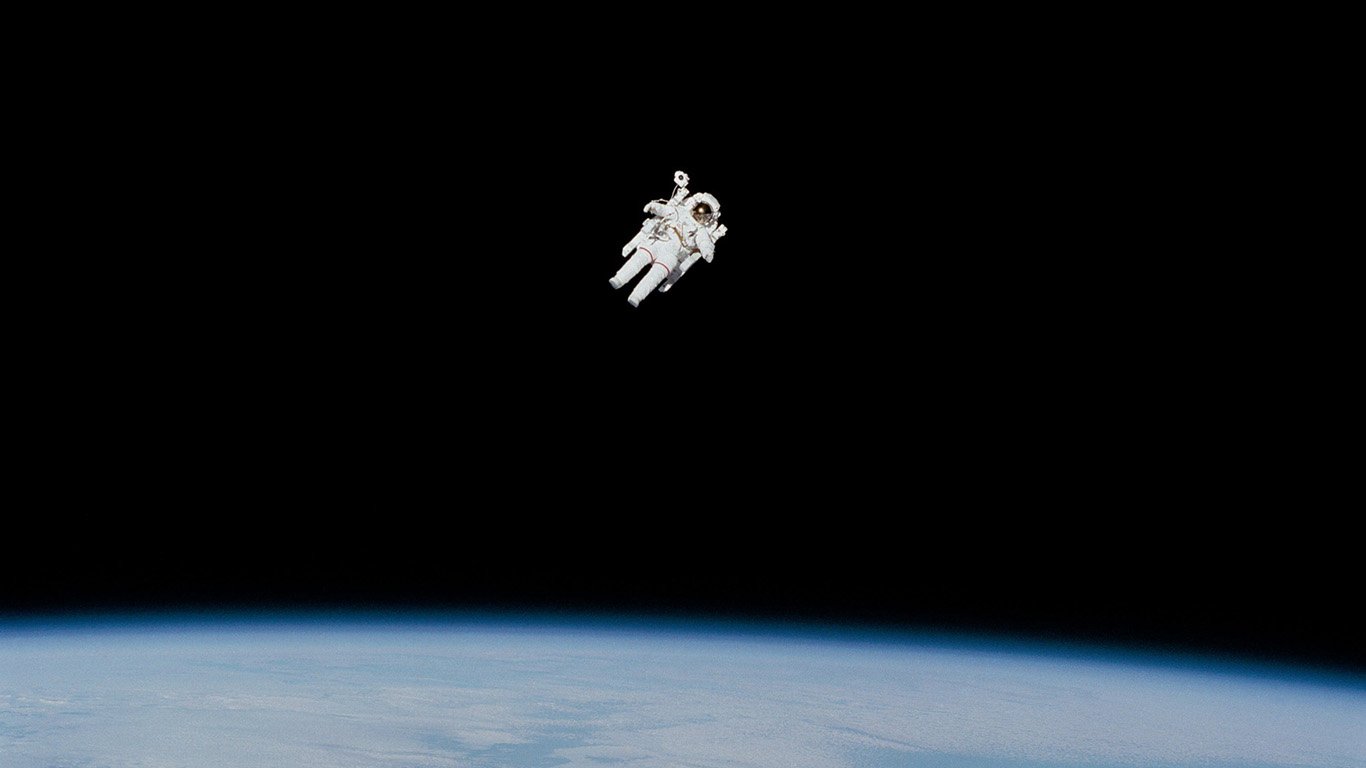 24/7 Wall St.
24/7 Wall St.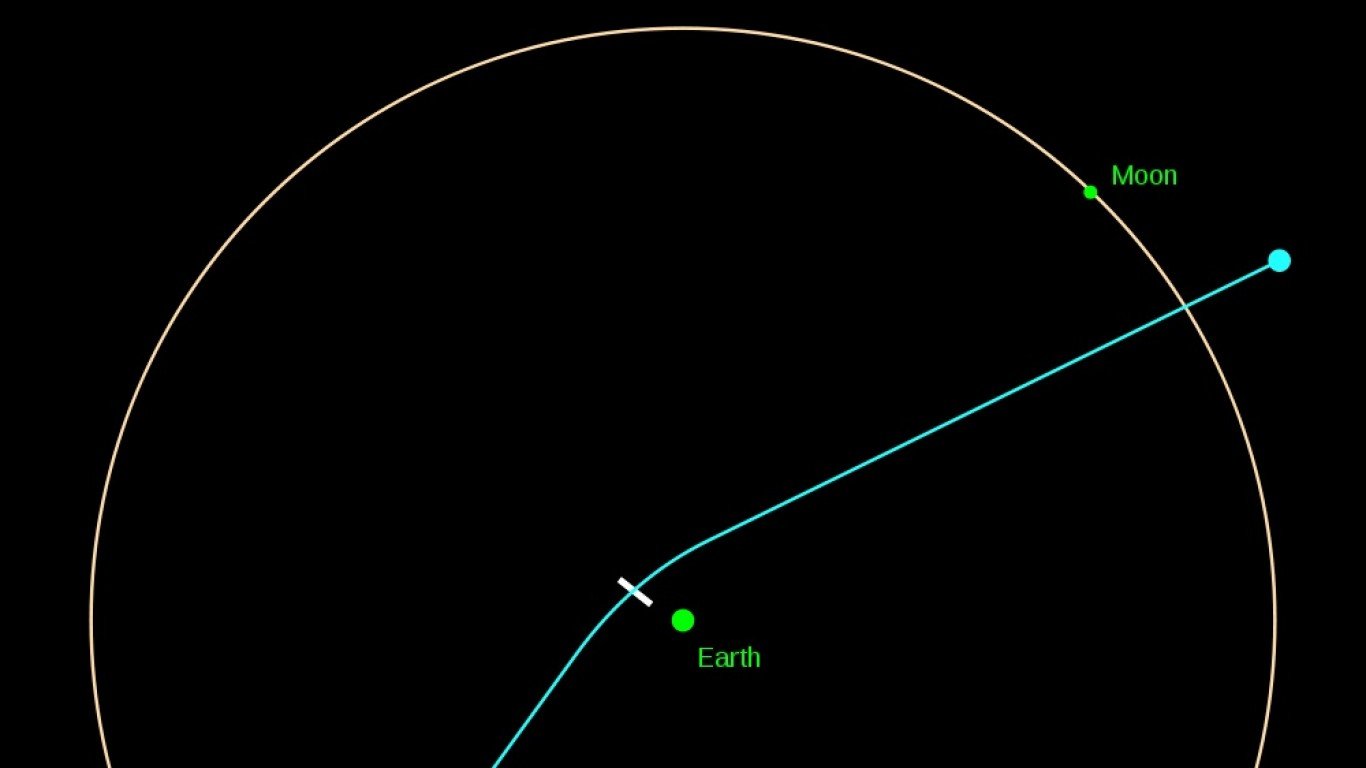
 24/7 Wall St.
24/7 Wall St.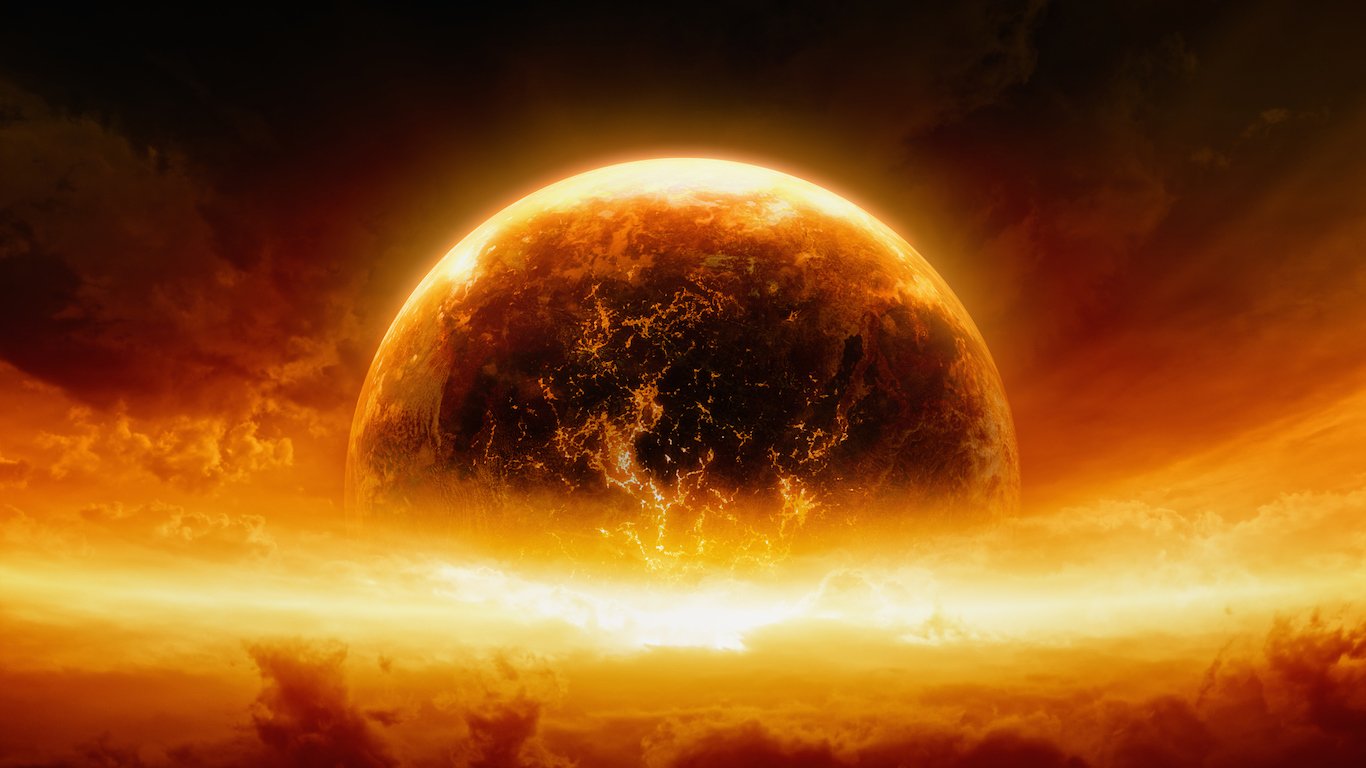 24/7 Wall St.
24/7 Wall St.

